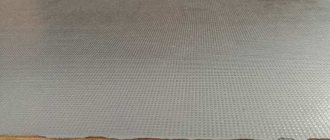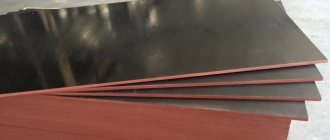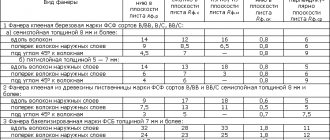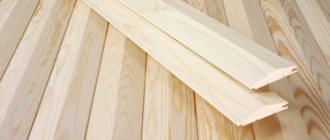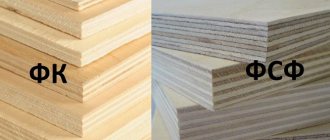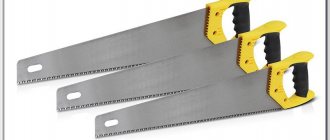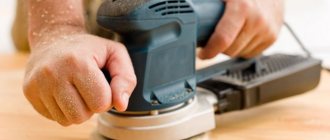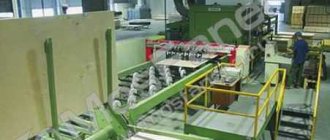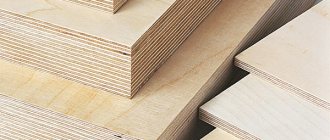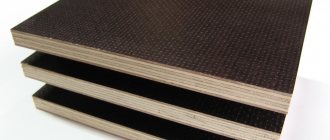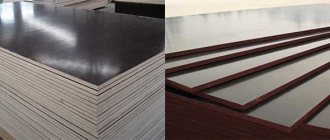What kind of material is this?
Bakelite plywood has many other names: marine, marine, marine, bakelite, wood-laminated plastic, delta wood, chipboard-10. It belongs to composite materials and is a rigid slab based on several layers of wood veneer impregnated with phenol-formaldehyde resins. Due to this composition, plywood is so dense and durable that its properties resemble amber or ebonite.
Important! Bakelite plywood is not at all afraid of moisture and literally repels it, while its service life in difficult conditions is at least 10-15 years.
Chipboard-10 is made from pine or birch veneer - thin wood plates that are impregnated with bakelite varnish (phenol-formaldehyde resin) or an alcohol solution of cresol-formaldehyde resin (less commonly). At a temperature of about +270 degrees under a pressure of 607.95 kPa (6 atm.), veneer strips are laid perpendicular to each other, pressed into a single whole and sheets of plywood are obtained.
After cooling, the chipboard-10 is once again treated with varnish to impart additional moisture-repellent properties. Some brands of material are sanded and laminated.
What does the price depend on?
The price of bakelized plywood, due to its exceptional qualities, is much higher than regular plywood, but, as professionals advise, it is better to use it.
Manufacturers of bakelite plywood in Russia, when setting prices, primarily focus on:
- Brand (since different types of resins are used);
- Reliability of the veneer used in production and its processing;
- Plywood sheet thickness and format: the larger, the more expensive.
But, you can always find the optimal price-quality ratio, for example, buying a thicker sheet will cost less than two thin ones.
Characteristics of plywood
The cost of bakelite plywood is higher than the price of its analogs, but the difference is due to high strength characteristics and improved properties. Main technical parameters of the material:
- density – 1200 kg/cubic. m (not lower than that of crushed stone, expanded clay concrete);
- tensile strength along the fibers – up to 88 MPa;
- static bending strength – 78.5 MPa;
- resistance to heat – up to +350 degrees;
- temperature range during operation is from -50 to +50 degrees.
Bakelite plywood does not support combustion and simply becomes charred when exposed to fire. It is not afraid of moisture and corrosion, while its strength is not inferior to metals, it has dielectric properties, and does not react with various chemicals (fuels, lubricants, weak acids, alkalis, sea water).
Properties of different types of plywood
Important! The material does not rot, is not at all susceptible to biodestruction, does not deform, and has increased wear resistance.
Many people are interested in how safe plywood is in everyday life, because it contains phenol-formaldehyde resins. Due to the peculiarities of production, it does not emit harmful substances into the environment, therefore it does not pose a danger to humans and can even be used in interior decoration. In addition, the material has a very attractive appearance, so it does not need to be supplemented with other finishing coatings.
On sale there are sheets of plywood of different sizes in rectangular and square shapes (length - 122-570 cm, width - 122-155 cm). The thickness of the material is 5-40 mm, the weight of one sheet is up to 85 kg.
Application
Bakelite sheets are used in the following areas:
- automotive industry: production of sides, floors, trailers, containers;
- shipbuilding: plating of small ships and sea yachts;
- hydraulic engineering: design of hydraulic locking equipment (sluices, hydraulic valves, etc.);
- construction: designing formwork for building up reinforced slabs, columns and other building elements, erecting canopies, partitions and other architectural forms.
It is worth noting that bakelite plywood is far from the cheapest building material, so not everyone can afford it.
Types and brands
When marking bakelite plywood, the characteristics, composition and precise production technology are taken into account, while the alphabetic and numerical designations are as follows:
- F – plywood;
- B – use of water-soluble resins for impregnation;
- B – bakelite coating;
- C – use of alcohol-soluble resins for impregnation;
- A – plywood for the automotive industry;
- 1 – impregnation of all layers, absence of a number – impregnation of only the outer layers.
The industry produces bakelite plywood of the following brands:
- FBS and FBS1 - material impregnated with phenol-formaldehyde resin for the construction of structures in the machine, ship, and automotive industries;
- FBV and FBV1 - material impregnated with water-soluble resins, requiring the application of an external paint coating (when operating in atmospheric conditions);
- FBS-A, FBS1-A – material impregnated with alcohol-soluble phenol-formaldehyde resin for the automotive industry.
Bakelized plywood Sveza FBV1-T 10 mm
Delta wood also differs in the way the sheets are processed. According to this criterion, the classification is as follows:
- The sheets are unpolished. Well suited for rough work.
- Sanded sheets. Ideal for finishing work, later treated with varnish.
- Laminated sheets. They have a ready-made finishing coating, do not require finishing, and are suitable for creating furniture.
Requirements
When producing marine plywood, there are some important quality requirements to consider. These can be found in British Standard 1088/66. And also all of them are enshrined in the domestic document GOST 11539-83 of 1985.
The standard provides for several separate grades of marine plywood.
- FBV. This type consists of sheets, for impregnation and gluing of which special water-soluble compounds are used. Most often it is phenol-formaldehyde resin. But at the same time it is applied only to the outer parts of the material.
- FBV1. This type is similar to the previous one. However, here phenol-formaldehyde resin is applied to both the external and internal sides.
- FBS. This grade of marine plywood is glued together using alcohol-soluble phenol-formaldehyde resin. Only the external parts are treated with this impregnation.
- FBS1. This type of stamp is treated with alcohol-soluble substances on both sides.
Marine plywood can be divided into 2 large groups - classic and non-classical grades. These types have different requirements. So, the first option is made from a special okume veneer. The products are distinguished by their relatively low weight, high level of flexibility and durability.
The classic variety has a laminated surface treated with waterproof compounds. The material is often used in combination with epoxy resin and fiberglass. This plywood is comparable in strength to carbon products. It is distinguished by special decorative properties, which determines its high cost.
More often it is used in the construction of decks for yachts and ordinary boats.
Non-classical plywood is made from various hardwoods, including beech, birch, and poplar. Cedar and pine are sometimes used. This plywood can be of a combined type. In this case, the top layer of the products is made of special peeled veneer, and the inner part is already made of hardwood.
This type should not be used for structural purposes - most often it is used for interior decoration or furniture production.
The cost of such materials will be slightly lower compared to the previous option.
In addition to the above requirements, there are other important nuances that should be taken into account when manufacturing and installing materials. The outer layers of sheets can only be made from solid strips of veneer. In the internal structure, merging of different elements with each other is permissible. In this case, the width of each strip must be at least 400 mm for the FBS brand or 200 mm for all other varieties.
In this case, the longitudinal rows of internal splicing should not coincide. Only in this case will the product be as durable and hard as possible. The outer surface of the plywood should not have areas that are not covered with transparent varnishes and other special compounds.
There should be no even small bubbles or unpressed areas on the surface of the sheet. Overlaps or irregularities with a height of more than 1 millimeter are also prohibited. All sheets can only be cut at right angles. In this case, the deviation per linear meter should be no more than 2 millimeters.
The ends of all sheets must be carefully processed.
On FBS brand models, the ends are treated with an additional layer of bakelite composition. On FBV brand samples they are coated with a special protective enamel.
Where is plywood used?
Most often, chipboard-10 is purchased for various construction works. It is used to make reusable formwork, canopies, partitions, and various architectural structures. The material is also suitable for the automotive industry - it is used to make floors in some types of transport and vans.
Permanent formwork
Plywood is in demand in the construction of ships, boats, sea containers, and is suitable for deck cladding. Furniture made from plywood lasts a very long time and does not require repair. You can even make a small summer house out of it for your dacha and garden. It will be beautiful, comfortable and cozy, as well as incredibly strong and durable, like other structures made from this wonderful lumber.
Classification of plywood by grade
The grade of plywood refers to the overall quality of the wood, the degree of its processing and the presence of visual defects.
Plywood is generally divided into 5 grades:
- Grade E. Selected plywood with a perfectly smooth surface and without visual defects. Only minimal deviations from the original structure of the wood itself are allowed.
- Grade 1. High-quality plywood with minor defects (warping and cracks) up to 20 mm.
- Grade 2. Medium quality plywood with permissible cracks up to 200 mm and glue protrusion of no more than 2% of the total surface area.
- Grade 3. Rejected plywood of average quality, which may contain small wormholes.
- Grade 4. Low quality plywood with a large number of acceptable visual and structural defects.
By the way! You can often see the markings “4/4” or “3/4”, this is how the sides correspond to a certain grade. One side of such plywood will be considered the front side, which is very beneficial when you need sheets solely for wall decoration.
Product classification
Essentially, plywood belongs to composite wood materials, which, in turn, are divided into two large categories:
- glued wood: solid, layered and combined;
- products from molded crushed wood: MDF plywood, chipboard, OSB, fiberboard.
Note! Plywood itself is produced in many types and grades. They differ in purpose, manufacturing features, level of processing, raw materials used, etc.
Thus, a product is called longitudinal when the fibers in its outer layer are located along the length of the sheet. If they are located along the width of the plywood, it is called transverse.
According to their purpose, the following types of wood-laminated sheets are distinguished:
- construction;
- industrial;
- packaging;
- furniture;
- structural.
The use of laminated material as wall cladding.
Based on the presence of cladding, two types of products are known: laminated plywood FOF (covered on both sides with a special film) and ordinary, unclad plywood.
Material and number of layers
- Softwood plywood is produced (in descending order) from pine, spruce, fir and larch veneers. Occasionally, quite expensive cedar is used to make it for decorative purposes. For this type of product, a mandatory condition is that the front and bottom layers are made of coniferous wood; deciduous varieties can be used in the inner layers.
- Hardwood analogues are in most cases made from birch veneer. Such products have increased strength. However, their price is relatively high, so hardwood plywood is not as common as coniferous plywood.
Sheets consisting of 9 and 13 layers of veneer.
According to the number of layers, sheets can be: three-, four-, five-, nine- and thirteen-layer.
In most cases, products have an odd number of veneer layers. Then the front surfaces are symmetrical to the middle layer.
When the sheet is four-layered, the inner layers are placed and laid perpendicular to the outer ones. This increases the strength of the products and their resistance to deformation.
Type of impregnating and adhesive composition
Many qualities of multilayer sheets depend on the type of glue and impregnation used.
Based on the type of composition data, the described material is divided into the following grades:
- FBA plywood is a material that was glued using a natural albumin-casein composition. Its main advantage is absolute environmental safety, the disadvantage is low water resistance. Therefore, such sheets can be used during construction only inside dry rooms.
The FSF brand is the most popular.
- The FSF brand is produced using phenol-formaldehyde resin glue. The material has fairly high wear resistance, strength and increased resistance to moisture. It is widely in demand in external and internal construction and in production.
- The letters FSF-TV indicate low-flammability and moisture-resistant products. This variety of the previous brand has all its positive qualities and, as an addition, belongs to the category of fire-resistant building materials. Used in carriage building, civil and industrial construction.
- PFA-T plywood is also fire-resistant. Peeled veneer for such material is first impregnated with a fire retardant compound - a fire retardant. The layers are fastened with phenol-formaldehyde glue, which makes the sheets moisture resistant.
- The FKM brand designates plywood with increased resistance to moisture, based on urea-urea glue.
- FC are sheets obtained by using glue based on urea-formaldehyde resin. The material does not have very high moisture resistance. Therefore, it is used only for internal construction work, as well as in the production of furniture, containers, packaging, children's toys, and souvenirs.
Bakelite plywood intended for shipbuilding.
- FB plywood is made from wood veneer, first impregnated with bakelite varnish and then glued with different types of glue. This brand has maximum resistance to aggressive environments. It can be used in harsh tropical climates, with increased humidity (even directly under water).
- FBS plywood - what is it. This variety of the previous brand is made using bakelite varnish and alcohol-soluble glue.
Note! This material has the highest technical characteristics among all types of wood-laminated sheets. It has ultra-high strength, resistance to aggressive environments, absolute waterproofness, it is flexible, resilient, and not subject to rotting or deterioration. At one time, such products were developed for use in shipbuilding and aircraft construction.
- FBV plywood is a material impregnated with bakelite varnish and bonded with water-soluble glue. Such products have all the positive characteristics of the bakelite brand, except for resistance to moisture, because the composition that holds the veneer layers together dissolves with water.
Environmental friendliness and level of processing
Products must have a sanitary and hygienic certificate.
According to the degree of processing of the sides, the material is divided into the following categories:
- sheets not sanded (marked NSh);
- products polished on one side (designation Ш-1);
- products in which both sides were polished (category Ш-2).
The instructions strongly recommend paying attention to the environmental safety of the material.
In this regard, according to the level of formaldehyde content, sheets are divided into emission groups:
- E-1, plywood of this class is the safest and contains no more than 10 mg of a toxic substance per 100 g of completely dry weight;
- E-2, such a product contains 10-30 mg of formaldehyde per 100 g of weight;
- E-3, this category contains 30-50 mg of chemical per 100 g of weight.
Conclusion
Now you know what all these numbers and letters mean on the packaging of the material.
Now manufacturers produce many brands, types and varieties of plywood. If you want to make something out of it with your own hands, you must understand them.
To make this task easier for you, we are posting a video in this article. If you still have questions then, ask them in the comments.
Classification of plywood by adhesive composition
The composition of the glue greatly affects the characteristics of the plywood sheet, so there are also separate classifications for it:
- FSF. Plywood based on phenoformaldehyde glue. It is characterized by increased moisture resistance and strength. The resin composition includes harmful substances, which is why FSF is not recommended for use in finishing residential premises and making furniture.
- FKM. Plywood based on melamine glue. Average level of moisture protection and concentration of harmful substances in the glue. A universal type of plywood that is suitable anywhere where there are no special requirements for moisture resistance and toxicity levels.
- FC. Plywood based on urea glue. The composition of the glue is absolutely harmless to humans, but does not provide the wood with high moisture resistance. An ideal plywood option for interior decoration.
- FBA. Plywood based on albumin casein glue. Environmentally friendly composition with the worst moisture resistance indicators. FBA plywood is absolutely non-moisture resistant and is only suitable for work in dry rooms.
- FB. Plywood based on bakelisite glue. An expensive and versatile option with a high level of moisture resistance and strength. Bakelite plywood is further divided into 2 categories: FBS. Alcohol-soluble adhesive provides the best moisture resistance of plywood.
- FBV. Water-soluble adhesive additionally strengthens the structure of the sheet and ensures high strength of the plywood.
By the way! Plywood markings may vary depending on the method of processing the layers with glue. For example, in FBV-1, the veneer layers are not impregnated with the composition, but are only coated. But in FBS-1A, not all layers are coated with glue, but only the longitudinal ones. Therefore, if you see such markings, you should know that the quality of such plywood will be slightly lower.
Division by type of wood
Based on the type of wood veneer, there are three types: birch, coniferous and combined. At the same time, they look only at the composition of the outer layers.
Berezovaya
Hardwood
Birch is a deciduous type of construction plywood. Birch bark veneer is a very durable and dense material that has a uniform structure.
On topic - what advantages does birch plywood have over coniferous plywood?
The density of such plywood is approximately 650 kg/m3, i.e. a sheet of such material is 20% stronger than a similar one made from another type of wood, but it does not contain natural resins at all, and it is more expensive.
It is mainly used where the unique properties of wood are required: strength and lightness. This is, first of all, large-scale and private construction, as well as carriage building, the automotive industry, shipbuilding, and packaging production.
History of the creation of the material
Bakelite is a material created by the Belgian chemist Baekeland. It is a reaction product of phenol and formaldehyde and has a number of interesting properties. It does not conduct electricity, does not melt, is heat-resistant, fire-resistant. When hardened, it forms a coating similar to amber, very durable. Their industrial use is based on these physical and chemical properties of bakelite resins.
During the war, wood veneer was impregnated with Bakelite-based varnishes. Special plywood was made from such veneer, which was used in the construction of aircraft and other equipment. A forced measure associated with interruptions in the supply of timber and other materials made it possible to create a material unique in strength, fire resistance and wear resistance.
Manufacturing methods
Tree bark is used to make plywood. The logs are pre-soaked in water and steamed. After which, the veneer is cut in several ways: planing, sawing and peeling. Peeling is considered the most effective method, because the thickness of the cut bark is minimal and wood raw materials are consumed optimally. This process occurs using a rotating machine on which the tree trunk is clamped. In this case, rotation occurs around the knife, cutting the bark in a circle.
Next, the cut bark is sorted, depending on the defects present, according to quality grades, and processed in a special way to form sheets. After which, the sorted sheets are impregnated with glue and pressed. At the same time, each layer is perpendicular to the next, which provides special strength. The final part is surface treatment by lamination or grinding. After which, the finished products undergo quality control, are labeled and packaged.
So, we examined in detail the types of plywood by grade and type of wood, as well as the application of each type. Among such a variety of different brands, everyone can choose the best option in terms of price and quality. Summarizing all of the above, we can say with confidence that if you need a wood building material that is easy to use, affordable, durable, lightweight, and resistant to environmental conditions, then it is best to choose plywood.
Dimensions and thickness
If you have decided on the type, purpose and grade, then further parameters for selecting and purchasing plywood are the thickness and dimensions of the sheet, because the cost depends on this.
According to GOST, the standard sheet dimensions are: 2440 x 1220 mm, but, at the same time, the most popular and convenient to use is: 1525 x 1525 mm. The following sizes are also offered: 1500 x 3000, 1525 x 3050 - in various variations of length and width, as well as non-standard sizes (determined by a specific manufacturer).
Dimensions according to GOST
The thickness of plywood from different manufacturers varies significantly within the range of 3-30 mm, and depends on the raw materials used in production and the number of layers in the product (from 3 to 21).
